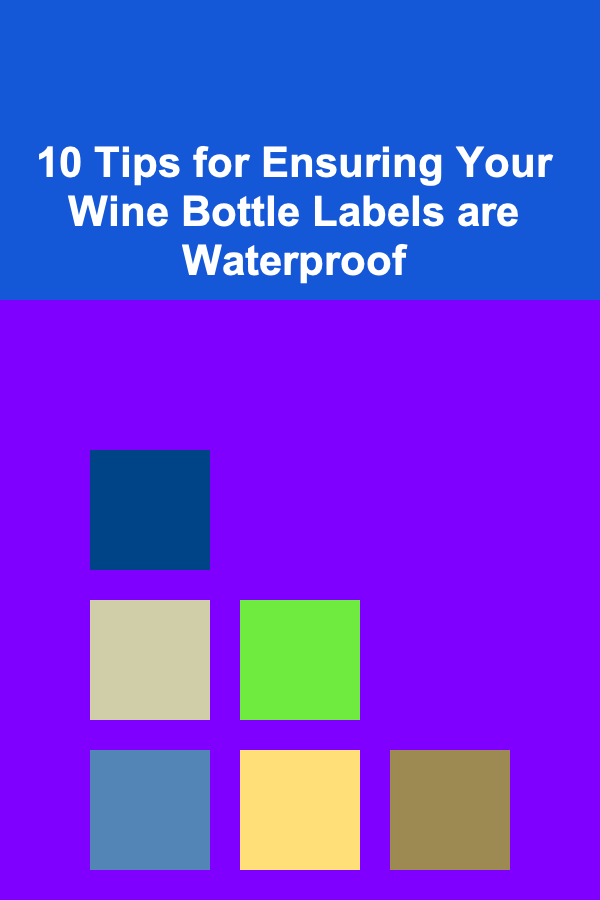
10 Tips for Ensuring Your Wine Bottle Labels are Waterproof
ebook include PDF & Audio bundle (Micro Guide)
$12.99$5.99
Limited Time Offer! Order within the next:

Wine bottle labels play a crucial role in the branding, presentation, and protection of your product. A well-designed label not only captures the essence of your wine but also provides essential information about the product. However, wine labels face a significant challenge: moisture. Whether the bottle is stored in a refrigerator, served chilled with condensation, or exposed to spills during a tasting or transport, the label is at risk of damage. Ensuring that your wine bottle labels are waterproof is essential to maintain the quality and appearance of your product and prevent costly reprints. Here are ten tips for making your wine bottle labels waterproof, ensuring that they stay pristine and legible throughout their journey.
Choose Waterproof Label Material
The first and most important step in ensuring your wine bottle labels are waterproof is selecting the right material. Traditional paper labels, while effective in many cases, do not stand up well to moisture and can quickly become damaged or illegible. To create a waterproof label, opt for specialized materials that are designed to resist water.
- Synthetic Paper: Materials like polypropylene, polyester, or vinyl are great choices. These synthetic options are durable and moisture-resistant, offering superior protection against water, oil, and general wear and tear.
- Waterproof Paper: Some brands offer "waterproof" paper, which is treated with a water-resistant coating, making it resistant to damage from moisture. It offers the look and feel of paper while providing better protection against wet conditions.
Choosing the right material is essential because it directly affects the durability of the label, its adhesion to the bottle, and its overall longevity.
Utilize Waterproof Inks
Inks play an equally important role in the durability of your wine bottle labels. Traditional printing inks may dissolve or run when exposed to water, leading to blurred text or distorted images. To ensure the printed design remains intact even in moist conditions, opt for waterproof inks.
- UV Inks: Ultraviolet (UV) inks are an excellent choice for waterproof labels. These inks are cured with UV light, making them resistant to water and fading. They are also highly durable and offer a vibrant finish.
- Solvent-Based Inks: Solvent-based inks are designed to withstand exposure to moisture and are often used in industrial and commercial applications. These inks dry faster and provide excellent waterproofing properties.
Waterproof inks will ensure that your wine bottle label maintains its crisp design and readability, regardless of the conditions it faces.
Consider Laminating the Label
Lamination involves covering the label with a thin, protective plastic layer that shields it from moisture, dirt, and damage. This extra layer not only makes the label waterproof but also adds an extra level of durability to prevent tearing or abrasion.
- Gloss Lamination: Provides a shiny, smooth finish that enhances the color and vibrancy of the label. It also helps repel moisture and fingerprints, keeping the label clean and readable.
- Matte Lamination: Offers a softer, non-reflective finish and provides the same waterproof protection. Matte finishes may be preferable for labels that require a more subdued, sophisticated appearance.
Laminating your wine bottle labels is one of the most effective ways to safeguard the label from moisture and increase its longevity.
Opt for Strong Adhesive Materials
The adhesive used for attaching the wine label to the bottle is another important factor to consider. A strong, waterproof adhesive ensures that the label stays firmly in place even when exposed to moisture or high humidity.
- Permanent Adhesives: Permanent adhesives are designed to create a lasting bond between the label and the bottle. They are ideal for ensuring the label stays intact throughout the product's lifespan.
- Waterproof Adhesives: Choose adhesives that are specifically designed to withstand water exposure. These adhesives are formulated to resist the effects of moisture and maintain the bond between the label and the bottle, even under wet conditions.
Selecting the right adhesive is essential to prevent peeling or curling of the label due to water exposure, ensuring your wine bottle label remains intact throughout its life cycle.
Use a Water-Resistant Coating
Another option for ensuring your wine bottle labels remain waterproof is applying a water-resistant coating to the label. This coating creates an invisible barrier that repels moisture, keeping the label safe from damage.
- Aqueous Coating: This coating is water-based and provides a thin, protective layer that makes the label resistant to water, dirt, and grease. It is ideal for labels that require a subtle gloss finish without the need for lamination.
- UV Coating: UV coating offers enhanced protection and durability. It provides a glossy finish and increases the label's resistance to moisture, scratches, and UV light, making it a popular option for high-end wine labels.
Water-resistant coatings are an excellent solution for ensuring that wine bottle labels can withstand exposure to moisture without compromising the look or functionality of the label.
Test and Evaluate the Materials
Before mass-producing wine bottle labels, it's essential to perform tests to ensure the materials you've chosen are truly waterproof. Conducting a test run allows you to assess how well the label holds up under real-world conditions.
- Submerge the Label: Try soaking a sample of the label in water for an extended period of time to test how it holds up. Check for fading, peeling, or distortion.
- Temperature and Humidity Tests: Expose the label to different temperatures and humidity levels to simulate conditions that the bottle may encounter in transit or storage.
These tests help you identify potential weaknesses in your label materials and make any necessary adjustments before final production.
Choose a Waterproof Bottle Design
The shape and type of bottle you use can also affect how the label interacts with water. While it may seem like a minor detail, ensuring that the bottle design minimizes the potential for moisture buildup can help maintain the integrity of your wine label.
- Shape Considerations: Bottles with straight sides or tapered designs are less likely to collect moisture at the seams where the label is attached. Bottles with irregular curves may cause water to pool along the edges, increasing the risk of label damage.
- Seal Quality: Ensure that the cork or cap is properly sealed to prevent moisture from entering the bottle. A secure seal helps reduce the chances of condensation forming on the exterior of the bottle.
By choosing a bottle design that minimizes moisture exposure, you can further protect the integrity of your wine label.
Store Wine Properly
Proper storage of your wine bottles is key to preserving the labels. Whether you are storing your wine at a retailer, in a warehouse, or in your own collection, it's important to keep the bottles in a controlled environment that minimizes moisture exposure.
- Temperature Control: Keep wine bottles in a cool, dry place with a stable temperature to prevent condensation buildup. Extreme temperature fluctuations can cause moisture to form on the bottle, potentially damaging the label.
- Humidity Control: Ensure the storage area has appropriate humidity levels. Too much humidity can lead to label deterioration, while too little can cause the adhesive to fail.
- Use Protective Cases: When transporting or storing wine bottles, consider using protective cases or boxes that shield the bottles from excessive moisture.
By storing wine properly, you help reduce the risk of label degradation and keep your product looking professional.
Avoid Direct Exposure to Water
While labels are designed to be waterproof, it is still essential to minimize direct exposure to water whenever possible. Although the label material may be resistant to moisture, extended exposure to water can still cause damage over time.
- Handle with Care: Avoid soaking the bottle or leaving it in wet environments for extended periods. Handling the bottle with care will ensure the label remains in pristine condition.
- Display Considerations: When displaying wine bottles at tasting events or on store shelves, ensure the bottles are not exposed to water from ice buckets, spills, or condensation.
By minimizing direct contact with water, you can further protect the integrity of the wine label and prolong its life.
Regularly Inspect and Maintain Your Labels
Regularly inspecting and maintaining your wine labels will help you identify any potential issues before they become major problems. Early detection allows you to take corrective action, such as replacing labels or reprinting them, before they affect the customer's experience.
- Routine Checks: Inspect the labels on stored bottles periodically to ensure there is no peeling, fading, or discoloration.
- Replace Damaged Labels: If a label becomes damaged due to moisture or other factors, replace it promptly to maintain the presentation and professionalism of your product.
Regular maintenance ensures that your wine bottles remain visually appealing and ready for sale or consumption.
Conclusion
Ensuring that your wine bottle labels are waterproof is essential for maintaining the quality and aesthetic of your product. By choosing the right materials, using waterproof inks and adhesives, and implementing protective measures like lamination and coatings, you can protect your labels from the damaging effects of moisture. Additionally, proper storage, handling, and inspection of the bottles will help extend the life of your labels and ensure that they remain attractive and legible. With these ten tips, you can ensure that your wine labels stand up to the rigors of moisture exposure while continuing to showcase your product with professionalism and elegance.
Reading More From Our Other Websites
- [Personal Care Tips 101] How to Use a Face Mask to Treat Acne-Prone Skin
- [Skydiving Tip 101] Must-Know Safety Tips Before Your First Jump
- [Trail Running Tip 101] Best Lightweight Hydration Packs for 50‑km Trail Races with Minimal Bulk
- [Home Security 101] How to Use Neighborhood Watch Programs for Better Home Security
- [Home Lighting 101] How to Light a Home Office for Maximum Productivity and Comfort
- [Biking 101] Bike Nutrition 101: Best Foods and Supplements for Cyclists
- [Home Family Activity 101] How to Set Up an Indoor Scavenger Hunt for Family Fun
- [Personal Care Tips 101] How to Choose a Facial Scrub That Targets Your Skin Concerns
- [Home Rental Property 101] How to Screen Tenants Without Discriminating
- [Tiny Home Living Tip 101] How to Manage Water Supply for Tiny Homes in Desert Environments

DIY Personal Care Products: Budget-Friendly Recipes for Glowing Skin
Read More
How to Use Bonds for Stable Income in Your Portfolio
Read More
How To Print Durable Outdoor Items with 3D Printing
Read More
How to Knit a Granny Square Blanket: A Checklist
Read More
10 Tips for Prioritizing Life Goals When You're Overwhelmed
Read More
10 Tips for Becoming a Certified Compliance Officer
Read MoreOther Products

DIY Personal Care Products: Budget-Friendly Recipes for Glowing Skin
Read More
How to Use Bonds for Stable Income in Your Portfolio
Read More
How To Print Durable Outdoor Items with 3D Printing
Read More
How to Knit a Granny Square Blanket: A Checklist
Read More
10 Tips for Prioritizing Life Goals When You're Overwhelmed
Read More